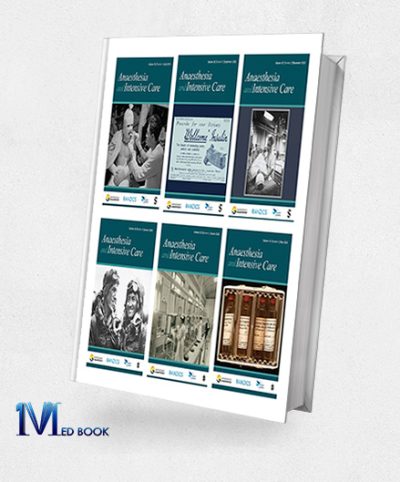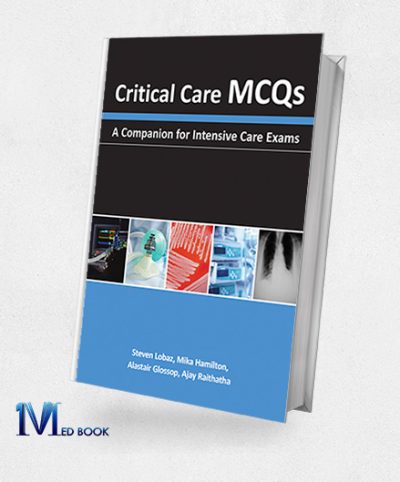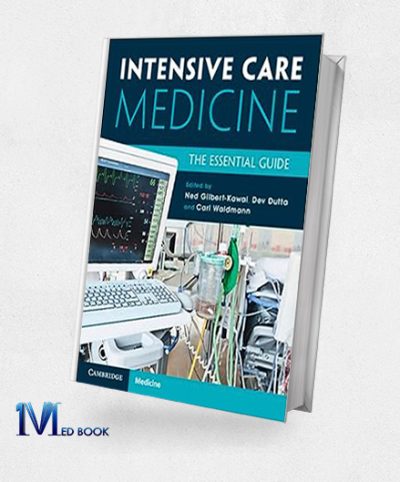Intensive Care
21 Common Diagnosis in ICU (Original PDF from Publisher)
Original price was: $61.99.$33.00Current price is: $33.00.A Case-Based Approach To Interventional Pulmonology A Focus On Asian Perspectives (Original PDF From Publisher)
Original price was: $106.14.$35.00Current price is: $35.00.American Journal Of Respiratory And Critical Care Medicine 2023 Full Archives (True PDF)
Original price was: $420.00.$60.00Current price is: $60.00.Anaesthesia and Intensive Care 2023 Full Archives (True PDF)
Original price was: $220.00.$40.00Current price is: $40.00.Anesthesia and Critical Care Clinics – 2 (Original PDF from Publisher)
Original price was: $55.00.$27.00Current price is: $27.00.Critical Care Update 2023, 5th Edition (Original PDF From Publisher)
Original price was: $94.00.$37.00Current price is: $37.00.Devices In Cardiac Critical Care (EPUB)
Original price was: $95.00.$27.00Current price is: $27.00.Devices In Cardiac Critical Care (Original PDF From Publisher)
Original price was: $95.00.$45.00Current price is: $45.00.Hall, Schmidt, and Wood’s Principles of Critical Care 5th Edition (EPUB)
Original price was: $199.00.$40.00Current price is: $40.00.Hall, Schmidt, and Wood’s Principles of Critical Care 5th Edition (Original PDF from Publisher)
Original price was: $199.00.$80.00Current price is: $80.00.Handbook Of Communication In Anaesthesia and Critical Care: A Practical Guide To Exploring The Art (Original PDF From Publisher)
Original price was: $114.00.$35.00Current price is: $35.00.Harvard Pulmonary And Critical Care Medicine 2024 (Videos)
Original price was: $1,475.00.$175.00Current price is: $175.00.Intensive Care Medicine MCQs (EPUB)
Original price was: $89.95.$21.00Current price is: $21.00.Intensive Care Medicine The Essential Guide (Original PDF from Publisher)
Original price was: $125.00.$35.00Current price is: $35.00.Manual Of Neurocritical Care (Original PDF From Publisher)
Original price was: $60.00.$32.00Current price is: $32.00.Mayo Clinic Case Review For Pulmonary And Critical Care Boards (Mayo Clinic Scientific Press) (Original PDF From Publisher)
Original price was: $115.00.$35.00Current price is: $35.00.MCQs in Intensive Care Medicine (EPUB)
Original price was: $79.95.$22.00Current price is: $22.00.Neonatal Intensive Care Nurse Exam Secrets Study Guide NIC Test Review for the Neonatal Intensive Care Nurse Exam (Original PDF from Publisher)
Original price was: $79.99.$26.00Current price is: $26.00.Obstetric Anesthesia And Uncommon Disorders, 3rd Edition (Original PDF From Publisher)
Original price was: $94.99.$27.00Current price is: $27.00.Pass CCRN (Adult), 6th Edition (Original PDF from Publisher)
Original price was: $72.99.$30.00Current price is: $30.00.SBAs and MCQs for Drugs in Anaesthesia and Intensive Care (Original PDF From Publisher)
Original price was: $50.00.$26.00Current price is: $26.00.The Advanced Practitioner In Acute, Emergency And Critical Care (Original PDF From Publisher)
Original price was: $69.50.$37.00Current price is: $37.00.Intensive Care
Introduction to Intensive Care: A Sanctuary for Critical Healing
In the ever-evolving landscape of modern medicine, Intensive Care emerges as a linchpin, offering a lifeline to those on the precipice of life-threatening conditions. Intensive Care Units (ICUs) stand as sanctuaries where the delicate dance between cutting-edge medical technology and the profound expertise of a multidisciplinary team unfolds, weaving together a tapestry of care that transcends the boundaries of traditional medical practice.
The Crucial Role of Intensive Care
At the heart of Intensive Care lies a profound understanding of the fragility of life and the imperative to intervene swiftly and decisively in the face of critical medical challenges. These units, often referred to as the last line of defense, are instrumental in providing a haven for patients navigating the treacherous waters of life-threatening conditions.
Symphony of Specialized Care
ICUs are not merely physical spaces; they are dynamic environments where a symphony of specialized care reverberates. Within their walls, healthcare professionals, armed with knowledge, compassion, and state-of-the-art technology, orchestrate interventions aimed at stabilization and support. The gravity of their mission is palpable, as every action taken within these units holds the potential to tip the scales in favor of life and recovery.
The Purpose Unveiled: Meticulous Monitoring
The purpose of ICUs is deeply rooted in the need for meticulous and continuous monitoring. Patients admitted to these units are not just recipients of care; they are subjects of constant vigilance. Be it a sudden cardiac event, respiratory distress, or the aftermath of a complex surgery, ICUs provide an environment where every heartbeat, every breath, and every fluctuation in vital signs are scrutinized with unwavering attention.
Where Expertise Meets Technology
The essence of ICUs lies in the seamless integration of cutting-edge medical technology with the collective expertise of a multidisciplinary team. It is a realm where the hum of ventilators harmonizes with the meticulous care provided by physicians, nurses, respiratory therapists, and a myriad of healthcare professionals. The amalgamation of technological precision and human touch creates an environment that transcends the traditional boundaries of medical care.
Navigating Complexities: The Multidisciplinary Approach
Critical illnesses seldom present in isolation; they often bring forth a myriad of complexities that require a comprehensive approach. ICUs embrace this reality by fostering a multidisciplinary ethos. Physicians, with their diagnostic acumen and decision-making prowess, collaborate seamlessly with nurses, the compassionate guardians at the bedside. Respiratory therapists contribute their expertise in managing the intricacies of the respiratory system, and a spectrum of healthcare professionals integrates their specialized skills to navigate the multifaceted challenges posed by critical illnesses.
The Nexus of Technology and Expertise
In ICUs, technology serves as an indispensable ally in the quest for healing. From advanced monitoring systems that provide real-time insights into a patient’s physiological state to sophisticated life-supporting devices such as ventilators, the technological arsenal deployed within ICUs is a testament to the relentless pursuit of innovation in the face of adversity. It is a marriage of technological prowess and human intuition, where each beep of a monitor and whirr of a machine resonates with the shared goal of preserving life.
A Haven for Critical Moments
ICUs are not merely clinical spaces; they are sanctuaries for critical moments. Families entrust their loved ones to the care of these units during some of the most challenging chapters of their lives. It is within these walls that the tides of uncertainty are met with unwavering dedication, where healthcare professionals become stewards of hope in the darkest hours.
Patient Monitoring in Intensive Care
In the crucible of intensive care, patient monitoring takes center stage. Advanced technologies such as ventilators, cardiac monitors, and continuous vital sign monitoring are deployed to assess and manage critically ill patients. These tools provide invaluable insights, enabling healthcare professionals to make timely and informed decisions crucial for the patient’s well-being.
Multidisciplinary Team in Intensive Care
The cornerstone of intensive care is the collaboration of a multidisciplinary team. Physicians, nurses, respiratory therapists, and various healthcare professionals work cohesively, coordinating care, making critical decisions, and offering comprehensive support to both patients and their families. The synergy of these diverse skills ensures a holistic approach to patient care.
Common Conditions in Intensive Care
Intensive care addresses a spectrum of medical emergencies, including sepsis, respiratory failure, and cardiac arrest. Here, rapid assessment and intervention strategies are deployed with precision, aiming to stabilize patients teetering on the brink of critical conditions.
Advanced Life Support in Intensive Care
The arsenal of intensive care includes advanced life support measures. Techniques such as advanced airway management, hemodynamic support, and extracorporeal membrane oxygenation (ECMO) play a vital role in sustaining vital functions during critical situations, offering a lifeline to patients in dire need.
Family-Centered Care in Intensive Care
In the challenging landscape of critical illness, family-centered care emerges as a guiding principle. Communication with families, involvement in decision-making, and the provision of emotional support become integral components, fostering a supportive environment during the arduous journey of intensive care.
LSI Integration – Critical Care Medicine
Critical Care Medicine seamlessly integrates into the fabric of intensive care. This comprehensive approach to managing critically ill patients reflects the continuous advancements in the field, underlining the unwavering commitment to refining strategies and techniques for the optimal benefit of patients in critical condition.
Neurocritical Care
Specialized care extends to patients with neurological emergencies in the realm of neurocritical care. Tailored interventions for traumatic brain injury and stroke are seamlessly integrated into the overall intensive care setting, recognizing the unique challenges posed by these conditions.
Infection Control in Intensive Care
Maintaining a safe environment in intensive care involves rigorous infection control measures. Strategies to prevent healthcare-associated infections, meticulous hand hygiene, and adherence to infection control protocols collectively contribute to safeguarding both patients and healthcare providers.
Rehabilitation in Intensive Care: Nurturing the Path to Recovery
The journey through intensive care is not a mere passage through stabilization; it extends beyond the immediate crisis, emphasizing the profound importance of rehabilitation. This phase, often overlooked, plays a pivotal role in the recovery process, focusing on early mobilization, physical therapy, and the management of Post-Intensive Care Syndrome (PICS). In the realm of intensive care, rehabilitation emerges as a beacon guiding survivors towards the restoration of functionality and the enhancement of their overall quality of life.
Beyond Stabilization: The Embrace of Rehabilitation
Intensive care is a crucible where lives are stabilized, and the arduous journey of recovery begins. However, the significance of this journey extends far beyond the walls of the ICU. It is within the realm of rehabilitation that survivors grapple with the aftermath of critical illness, striving to reclaim not just physical function but the essence of their pre-illness selves.
Early Mobilization: A Catalyst for Recovery
Early mobilization stands as a cornerstone of rehabilitation in intensive care. The traditional notion of bed rest as a means of recovery has been challenged, giving way to a paradigm where movement is seen as a catalyst for healing. Patients, once tethered to the confines of their beds, are encouraged to engage in progressive activities that foster strength, endurance, and the restoration of functional independence.
The benefits of early mobilization are manifold. Physical activity in the early stages of recovery prevents muscle atrophy, enhances cardiovascular function, and mitigates the risks associated with prolonged immobility. Beyond the physical realm, it contributes to mental well-being, combating the psychological toll of extended bed rest and fostering a sense of agency in patients.
Physical Therapy: Guiding the Path to Functional Recovery
Physical therapy is a linchpin in the rehabilitation journey, offering a structured and tailored approach to restoring physical function. In the aftermath of critical illness, patients may face a myriad of challenges, ranging from muscle weakness to joint stiffness. Physical therapists, armed with expertise, design individualized rehabilitation programs that address these challenges, promoting strength, flexibility, and overall functional independence.
The rehabilitation process involves a spectrum of exercises aimed at improving mobility, balance, and coordination. Therapists work closely with patients, guiding them through targeted movements, therapeutic exercises, and adaptive strategies to overcome physical limitations. The goal is not just to restore what was lost but to empower patients with the tools to navigate their post-ICU lives with resilience and confidence.
Post-Intensive Care Syndrome (PICS) Management: Addressing the Invisible Scars
The aftermath of intensive care is not always visible; it often manifests in the form of Post-Intensive Care Syndrome (PICS). PICS encompasses a constellation of physical, cognitive, and psychological impairments that can persist long after the acute phase of illness has passed. From muscle weakness and joint pain to memory deficits and emotional challenges, PICS casts a shadow on the trajectory of recovery.
Managing PICS requires a nuanced and comprehensive approach. Rehabilitation programs are tailored to address the specific challenges faced by each patient. Cognitive rehabilitation, encompassing memory exercises and cognitive-behavioral therapy, aids in restoring mental acuity. Emotional well-being is fostered through counseling and support groups, acknowledging the psychological toll of the intensive care experience. The holistic management of PICS recognizes that true recovery extends beyond the physical realm, encompassing the restoration of cognitive function and emotional resilience.
End-of-Life Care in Intensive Care: Navigating the Ethical Crossroads
In the poignant moments when the trajectory of recovery diverges, and the inevitability of life’s end becomes apparent, end-of-life care takes center stage. Within the ethically charged environment of intensive care, effective communication strategies with families and the implementation of palliative care principles are paramount.
Effective Communication Strategies: Nurturing Understanding and Empathy
The end-of-life journey is a profound and deeply emotional experience for patients, families, and healthcare providers alike. Effective communication strategies in these moments transcend the imparting of medical information; they become conduits for understanding, empathy, and shared decision-making.
Healthcare professionals in intensive care navigate the delicate balance between transparency and compassion. Open and honest communication about the patient’s prognosis, treatment options, and the potential for a transition to palliative care creates a foundation for trust and collaboration. It empowers families to actively participate in decision-making, aligning medical interventions with the patient’s values and wishes.
Palliative Care: Embracing Comfort and Support
As patients approach the end of their lives in the intensive care setting, the principles of palliative care come to the forefront. Palliative care is not synonymous with abandonment; rather, it represents a shift in focus from curative interventions to measures aimed at enhancing comfort and quality of life.
In the emotionally charged environment of intensive care, palliative care specialists work in tandem with the multidisciplinary team to address physical symptoms, manage pain, and provide emotional support. The goal is to ensure that patients experience a dignified and peaceful transition, free from unnecessary suffering. Palliative care extends its embrace beyond the patient, enveloping families in a cocoon of support during the challenging and poignant moments surrounding the end of life.
Quality Improvement in Intensive Care: A Continuous Evolution
The commitment to excellence in intensive care is not a static goal; it is an ongoing commitment to improvement and evolution. Quality improvement initiatives in ICUs reflect a dynamic response to the changing landscape of healthcare, with a focus on enhancing patient outcomes, reducing complications, and elevating the overall standard of care.
Enhancing Patient Outcomes: A Continuous Aspiration
Quality improvement initiatives in intensive care are guided by a relentless pursuit of optimal patient outcomes. This involves a systematic approach to evaluating and refining care practices, incorporating evidence-based interventions, and harnessing data-driven insights to enhance the effectiveness of medical care.
Healthcare professionals in intensive care engage in continuous education and training, staying abreast of the latest research and best practices. By fostering a culture of continuous learning, ICUs position themselves at the forefront of medical advancements, ensuring that patients receive care that is not only evidence-based but also aligned with the latest innovations in the field.
Reducing Complications: A Proactive Stance
Complications, whether arising from medical interventions or the inherent complexities of critical illness, pose formidable challenges in intensive care. Quality improvement initiatives are designed to proactively identify and mitigate potential complications, ranging from infections to adverse drug reactions.
Through robust infection control protocols, vigilant monitoring, and a commitment to best practices, ICUs strive to create an environment that minimizes the risk of complications. Rapid response teams are poised to address emergent situations, ensuring that deviations from the optimal course of care are addressed promptly and effectively.
Elevating the Overall Quality of Care: A Collaborative Endeavor
The overall quality of care in intensive care units is a collective endeavor that involves not only healthcare professionals but also patients, families, and administrators. The pursuit of excellence transcends individual disciplines, fostering a collaborative ethos where every stakeholder plays a role in shaping the care environment.
Patient and family engagement initiatives empower individuals to actively participate in their care journey. Open communication channels between healthcare providers and patients ensure that care plans are not only medically sound but also aligned with the patient’s values and preferences. Additionally, feedback mechanisms and regular audits contribute to a culture of continuous improvement, where the focus is not only on addressing challenges but also on identifying opportunities for innovation and enhancement.
Conclusion: A Symphony of Resilience and Hope in Intensive Care
In the concluding notes of our exploration into the intricate world of intensive care, it becomes evident that this landscape is not just a realm of medical interventions; it is a symphony of resilience, dedication, and unwavering hope conducted by healthcare professionals. Their commitment to providing critical care, coupled with a relentless pursuit of advancements, transforms intensive care into a beacon of hope for those treading the tumultuous waters of critical conditions.
Dynamic Challenges and Unyielding Resilience
The landscape of intensive care is inherently dynamic, marked by the constant ebb and flow of critical challenges. Yet, it is precisely within this dynamic interplay that the resilience of healthcare professionals shines brightest. The intensive care unit is a theater where the drama of life and death unfolds daily, and the healthcare professionals within its walls stand as stalwart guardians, undeterred by the formidable challenges that each day may bring.
A Commitment Beyond the Call of Duty
The unwavering commitment of healthcare professionals in the realm of intensive care goes beyond the call of duty. It is a commitment to be present at the bedside during the darkest hours, to make split-second decisions that carry profound consequences, and to navigate the emotional intricacies that accompany critical illness. This commitment is a testament to the ethos that propels the practice of critical care—a commitment forged in the crucible of empathy, compassion, and a profound understanding of the sanctity of life.
Advancing the Field: A Continuous Odyssey
The dedication to advancing the field of intensive care is a defining characteristic that sets healthcare professionals in this domain apart. It is an acknowledgment that the pursuit of excellence is an ongoing odyssey, a journey that involves staying at the forefront of medical knowledge, embracing technological innovations, and continually refining the art and science of critical care. In the ever-evolving landscape of medicine, healthcare professionals in intensive care embody a spirit of perpetual learning and adaptation.
A Beacon of Hope in Vulnerability
Intensive care, with its sophisticated interventions and multidisciplinary collaboration, stands as a beacon of hope for individuals in their most vulnerable moments. It is a sanctuary where patients and their families find solace amid the uncertainties of critical conditions. The expertise, compassion, and tireless efforts of healthcare professionals transform the sterile walls of the ICU into a haven where hope is not just a concept but a palpable force that permeates the atmosphere.
The Resilience of Healthcare Professionals
The resilience of healthcare professionals in intensive care is a source of inspiration. In the face of life’s fragility, they navigate the complexities of critical illnesses with grace and fortitude. It is a resilience that extends beyond the clinical realm—it is the ability to find strength amidst the emotional toll, to persevere in the wake of loss, and to continuously adapt to the ever-changing landscape of medicine.
The Human Element in Critical Care
While technology and medical advancements play pivotal roles in intensive care, the essence of critical care lies in the human element. Behind every ventilator adjustment, every medication administered, and every decision made, there is a healthcare professional who brings not only expertise but also a profound sense of humanity to the bedside. This human touch, often underestimated in its impact, is the cornerstone of the compassionate care provided in intensive care units.
Collective Determination for Patient Benefit
The ongoing pursuit of excellence in intensive care is a collective determination to benefit patients in their most vulnerable moments. It is a commitment shared by healthcare professionals, researchers, and policymakers alike. Through continuous collaboration, the goal is not merely to maintain the status quo but to push the boundaries of what is possible, offering patients the best chances for recovery and improved quality of life.
Conclusion: A Symphony of Hope
In conclusion, intensive care is not merely a specialty within medicine; it is a symphony of hope, resilience, and unwavering commitment. It is a testament to the human spirit’s capacity to confront adversity and emerge stronger. As we navigate the dynamic landscape of intensive care, we witness the profound impact of healthcare professionals who, in their dedication to healing, illuminate the path forward for those in critical conditions. Intensive care remains a beacon—a beacon that casts its light not just on the challenges of today but on the possibilities of tomorrow, fostering a continuous evolution in the pursuit of excellence for the well-being of patients in their most vulnerable moments.


























